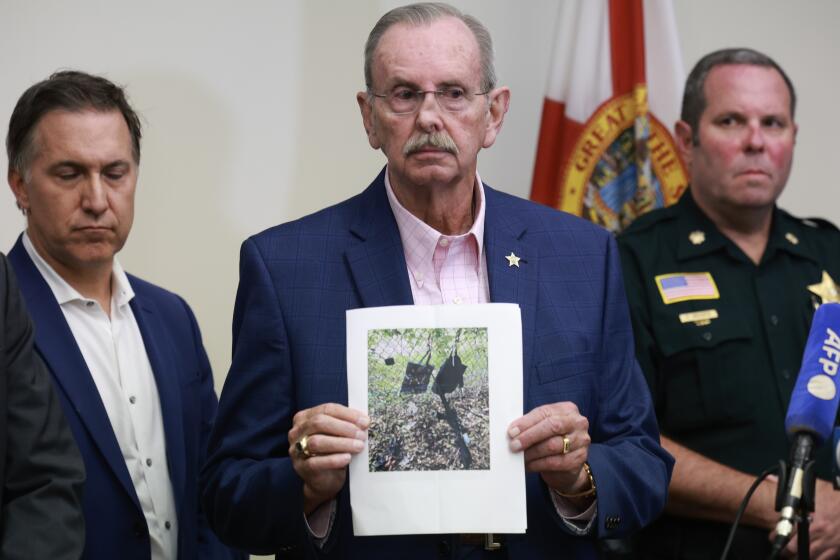Court’s use of video is facing review
So many people came to listen to lawyers argue the death penalty appeal of convicted Chino Hills murderer Kevin Cooper that dozens of overflow spectators had to watch from the courthouse cafeteria on a closed-circuit television.
But three seats remained empty during the hearing last week in the large ceremonial courtroom of the U.S. 9th Circuit Court of Appeals. They were the chairs reserved for the judges, who were hundreds of miles away, listening to the arguments via video hookup, and occasionally asking questions.
The 9th Circuit, which considers appeals in federal cases from nine western states, including California, Alaska and Hawaii, plus Guam and the Mariana Islands, has had the technological capacity to conduct oral arguments via video for seven years. But the Cooper hearing marked the first time that an argument was held with none of the judges present, according to Mary M. Schroeder, the 9th Circuit’s chief judge.
In an interview late last week, Schroeder, who is based in Phoenix, said she was troubled by the development, and may propose curbs on judicial videoconferencing.
“I was at the courthouse in San Francisco on Tuesday, and I was very surprised and concerned when I learned all three judges were on video,” Schroeder said. “That was a first. Several other judges are concerned as well, and we are going to have a full discussion as soon as we can.
“I don’t think this is going to happen again.”
Videoconferencing for oral arguments was introduced in several of the nation’s federal circuits between 1998 and 2001. Supporters say it saves travel time and increases court efficiency, while detractors worry that it eliminates important personal interplay between lawyers and judges.
Federal appeals court judges may spend months on a case, reviewing briefs, discussing the case with colleagues and law clerks, writing and rewriting opinions. But the oral arguments are the only time that those judges, who have lifetime tenure, interact with the lawyers. In serious cases, each side gets half an hour. In some instances, the attorney barely utters a sentence or two before the judges start posing pointed questions.
The first time the 9th Circuit used the video system, it was in 2000 for the convenience of lawyers from Guam, who wanted to save the time and expense of flying to San Francisco. The judges assembled at the San Francisco courthouse, and the lawyers argued via video from Guam.
The circuit stepped up use of video for oral arguments several years ago when one judge faced medical problems that prevented him from flying. However, in recent months, an increasing number of 9th Circuit judges have invoked their privilege of appearing via video, even when they did not have a compelling reason, according to judges on the court who spoke on a not-for-attribution basis.
Two judges on the court took particular umbrage at a colleague who they said had recently informed the court that it would be inconvenient to attend arguments because they would conflict with a child’s basketball games.
Veteran 9th Circuit Judge Stephen Reinhardt, though declining comment on the Cooper arguments, said he was troubled by judges’ increasing tendency to participate in oral arguments via video.
“I may be a traditionalist, and somewhat of a conservative, but I believe that attorneys who come to court to argue are entitled to directly engage the judges who are deciding their clients’ rights,” said Reinhardt, whose chambers are in Los Angeles. “After all, that’s what we were appointed to do -- show up in court and hear cases.”
The Cooper case has attracted a lot of interest, both because of the brutality of the murders -- in which a couple and two children were hacked to death in Chino Hills in 1983 -- and allegations that Cooper was framed.
Norman Hile and Holly Wilkens, the two lawyers who squared off at the Cooper hearing, delivered their arguments while facing a television screen. Each attorney could see his/her image and that of two of the three judges -- Ronald M. Gould, who was in Seattle, and M. Margaret McKeown, who was in San Diego -- displayed on a split-screen. Gould has serious health problems that make it dangerous for him to fly, according to Cathy Catterson, the 9th Circuit’s chief clerk.
A technical glitch meant the lawyers and the other judges could only hear, but not see, Judge Pamela Ann Rymer, who was in Pasadena. The other two judges could see each other as well as the lawyers.
Hile, who represents Cooper, drove from Sacramento for the argument. He declined comment on the hearing format. Wilkens, a deputy state attorney general, who flew from San Diego to argue in favor of the death sentence, said that the format “made absolutely no difference” on how she presented her case.
The Times sent the three judges assigned to the Cooper case an e-mail asking for their views on the subject of judges hearing argument via video. All three answered with similar responses:
“As I am sure you understand, I cannot comment on anything that might even remotely appear to relate in any way to a pending case,” Rymer said in an e-mail. McKeown responded: “As I am sure you appreciate, it is not appropriate under the ethics rules to comment on pending cases.”
Along the same line, Gould said, “I feel that the ethics rules precluding comment on pending cases require that I not respond to your inquiry at this time.”
The Code of Conduct for the federal bench states that “a judge should avoid public comment on the merits of a pending or impending action.” However, the code adds, “this proscription does not extend to public statements made in the course of the judge’s official duties, to the explanation of court procedures, or to a scholarly presentation made for purposes of legal education.”
Several legal scholars said they were concerned about the growing trend by the 9th Circuit, and some other federal circuits, to conduct oral arguments with one or more of the participants absent.
“This is quite a dramatic manifestation of a phenomenon,” University of Pittsburgh law professor Arthur Hellman said about the Cooper hearing.
“Argument via videoconference is awkward in that it can be difficult to have visual contact with all the judges,” Hellman said, referencing comments made by participants at a national conference on appellate arguments in 2005. Dropped or bad connections, like the one that left Rymer out of the video hookup, were cited as drawbacks.
“In addition, the procedure denies lawyers the nonverbal cues they get from the judges when the judges and the attorneys are assembled in the same location,” Hellman said.
“It is a trend ... that I find very disturbing,” said Duke University law professor Erwin Chemerinsky, who taught at USC for many years and follows the 9th Circuit closely. “The interaction among the participants is just different when everyone is there, as opposed to when some or all are present electronically.”
Chemerinsky also said he found it “especially disturbing” that judges would not personally attend arguments in a capital case, unless they had good reason.
On the other hand, New York University law professor Stephen Gillers and Northwestern University law professor Steve Lubet said they had no problem with arguments via video.
Lubet said “it has the potential to reduce costs for the courts and for litigants. I doubt that it will have serious diminution in advocacy.”
Gillers said the use of video for oral argument “makes a great deal of sense,” especially in the 9th Circuit, the nation’s largest. “Videoconferencing is on the increase in law and business. Why not appeals? We gain in efficiency -- saving time and money -- and sacrifice little, mainly nostalgia for the old days,” said Gillers, an ethics specialist.
The 9th Circuit has a general order stating that its judges are expected to be present for “en banc” arguments, those heard by a large panel of jurists, either 11 or 15 judges, in cases of particular significance. Currently, Schroeder said, the 9th Circuit has no formal rule governing when a judge has to be present for an oral argument before a three-judge panel, but that could change.
There was one set of cameras that the court declined to allow in the courtroom during the Cooper arguments. KNTV Channel 11, an NBC affiliate based in San Jose, formally asked the court for permission to videotape the hearing for later broadcast.
But the day before the hearing, the three judges, without explanation, denied the station’s request, apparently deciding that it would be unwise for the general public to watch the proceedings on television.
More to Read
Get the L.A. Times Politics newsletter
Deeply reported insights into legislation, politics and policy from Sacramento, Washington and beyond. In your inbox three times per week.
You may occasionally receive promotional content from the Los Angeles Times.










